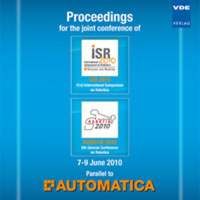Development of Image Guided Master-Slave System for Minimal Invasive Brain Surgery
Konferenz: ISR/ROBOTIK 2010 - ISR 2010 (41st International Symposium on Robotics) and ROBOTIK 2010 (6th German Conference on Robotics)
07.06.2010 - 09.06.2010 in Munich, Germany
Tagungsband: ISR/ROBOTIK 2010
Seiten: 6Sprache: EnglischTyp: PDF
Persönliche VDE-Mitglieder erhalten auf diesen Artikel 10% Rabatt
Autoren:
Seung, Sungmin; Kang, Byungjeon; Kim, Wooyoung; Park, Jongoh; Park, Sukho (Chonnam National University, Department of Mechanical Engineering, 500-757, Gwangju Korea)
Inhalt:
The minimal invasive surgery has many advantages of operations which are less lost of blood and painless using a thin long pole shape surgical instrument. For all that of these advantages, it has defects of difficulties of visual insurance and limitations of moving surgical instruments. In case of the minimal invasive brain surgery using master-slave system, it is also fatal that the end-effector of the robot would be placed to out of the target region due to minimal invasive surgery operation by untrained person. This paper not only proposes an image guided master-slave system involving force-feedback navigation on the patient image, but also presents our developed master-slave system for minimal invasive brain surgery. The master manipulator has 4 degree of freedom (DOF) mechanism for the end-effector of slave position and direction. Similarly, the end-effecter for the minimal invasive brain surgery has a thin long pole shape of 4 DOF instrument. The master manipulator and slave end-effectors have a similar configuration and 4-DOF mechanism which consists of a linear motion and 3 rotational roll-pitch-yaw motions. We also conducted an image guided system that helps a surgeon to comfortably operate minimal invasive surgery in safe by using the developed master-slave system. In order to implement the image guided master-slave robot system, it requires the coordinate matching among the surgical robot, virtual image model, and real model of the patient. The image guided master-slave system that display the position of a patient’s local environment and robot position is developed using 3D position tracking system. Moreover, the system can be controlled a force-feedback when a collision between an image coordinate of target region and end-effector coordinate of the robot. The various experimental results are executed to evaluate the performances of the proposed image guided master-slave system for minimal invasive brain surgery.


